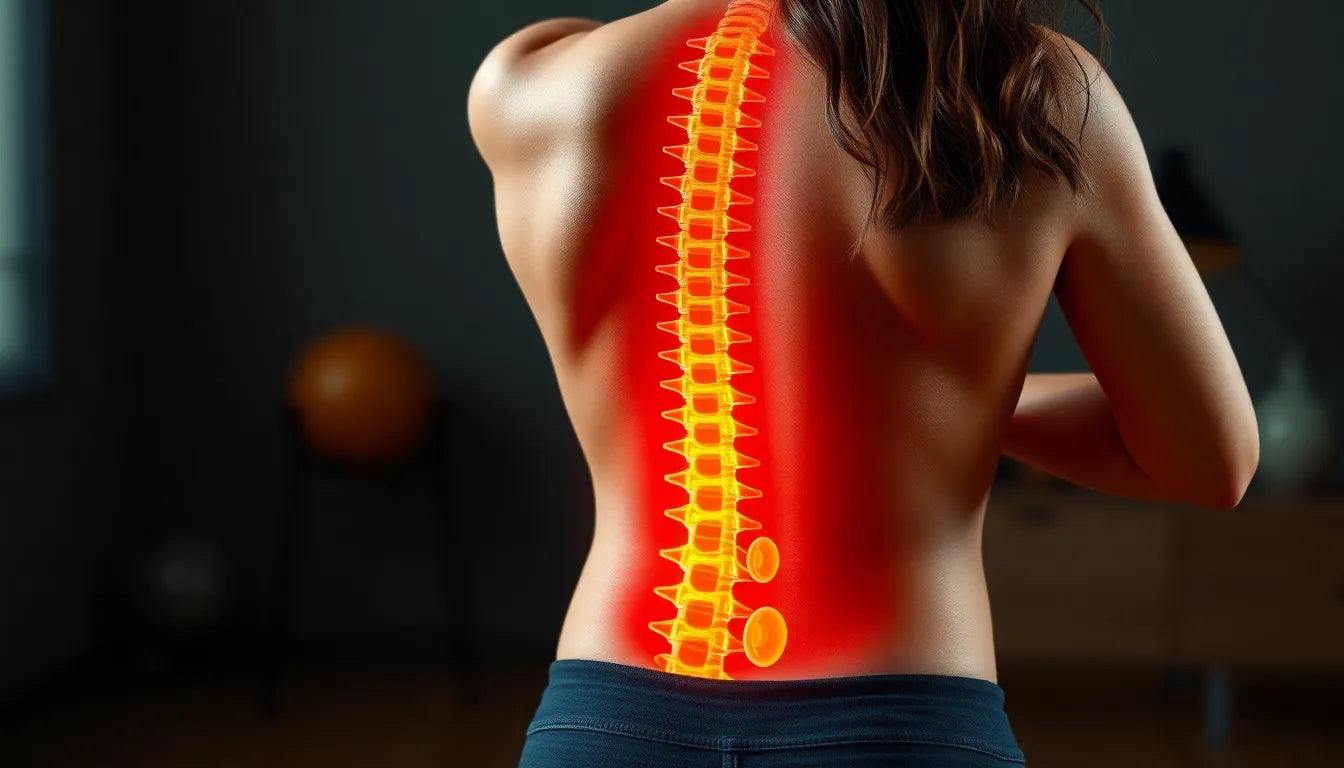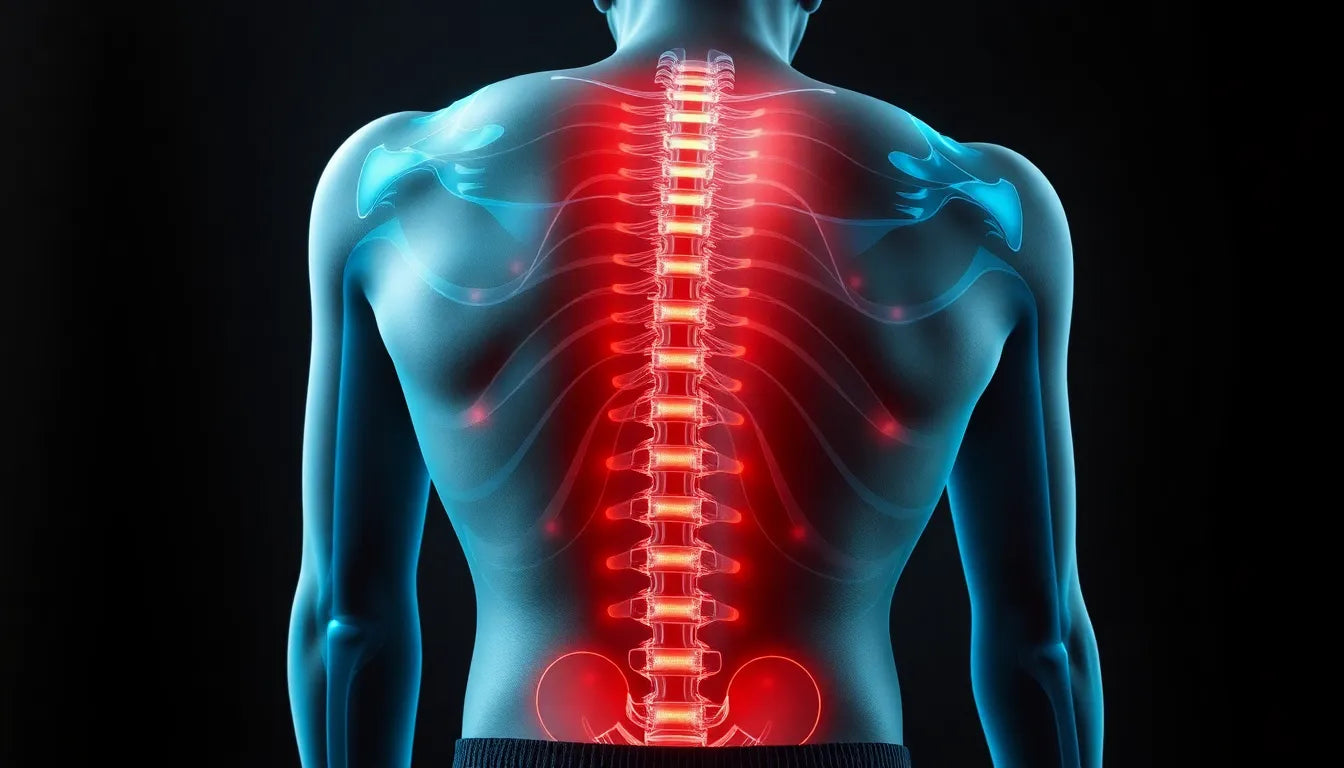Radiating lower back pain is a common yet complex issue that affects millions of people worldwide. Unlike localized back pain, which is confined to a specific area, radiating pain extends beyond the lower back, often traveling down the legs. This type of pain is typically associated with nerve involvement, such as sciatica or a herniated disc, and can stem from both mechanical and non-mechanical origins. Understanding the nuances of this condition is crucial for effective management and relief.
Understanding radiating lower back pain
Radiating lower back pain differs from localized pain in its reach and intensity. It often indicates nerve irritation or compression, with the sciatic nerve being a common culprit. Conditions like herniated discs or spinal stenosis can lead to this type of pain, where the discomfort is not just felt in the lower back but also radiates to other parts of the body, such as the buttocks, thighs, or even feet. Mechanical causes include issues with the spine's structure, while non-mechanical causes might involve systemic diseases or infections.
Addressing both acute and chronic phases of radiating pain is essential. Acute pain may arise suddenly, often due to an injury, and might resolve with time and proper care. Chronic pain, however, persists for weeks, months, or even longer, requiring ongoing management strategies to improve quality of life. Recognizing the phase of pain can guide appropriate treatment and intervention.
The prevalence and impact
Radiating lower back pain is not just a personal health issue; it's a global concern with significant economic implications. According to recent statistics, lower back pain is one of the leading causes of disability worldwide, affecting daily activities and productivity. The economic burden is substantial, with billions spent annually on healthcare costs, lost wages, and reduced work capacity.
The impact on quality of life is profound. Those suffering from radiating lower back pain often experience limitations in mobility, difficulty performing everyday tasks, and a decrease in overall life satisfaction. This underscores the importance of early intervention and effective management strategies. Addressing the pain early can prevent it from becoming a chronic issue, reducing its impact on daily life and economic productivity.
In conclusion, understanding radiating lower back pain and its implications is the first step toward effective management. By recognizing the symptoms and causes, individuals can seek timely medical advice and adopt strategies to alleviate pain and improve their quality of life. As we explore further, we'll delve into the symptoms, diagnosis, and treatment options that can help those affected by this challenging condition.
Symptoms and diagnosis of radiating lower back pain
Radiating lower back pain often presents with a range of symptoms that can vary in intensity and duration. Common symptoms include a sharp or burning pain that travels from the lower back down the leg, often accompanied by numbness or tingling sensations. In some cases, individuals may experience muscle weakness, which can significantly impact mobility and daily functioning.
Diagnosing radiating lower back pain requires a comprehensive approach. Healthcare professionals typically begin with a detailed medical history and physical examination to identify potential causes and assess the severity of symptoms. Imaging tests, such as X-rays, MRI, or CT scans, may be recommended to visualize the spine's structure and identify issues like herniated discs or spinal stenosis. In some instances, nerve conduction studies or electromyography (EMG) might be utilized to evaluate nerve function and pinpoint the source of nerve irritation.
It's crucial to recognize red flag symptoms that necessitate immediate medical attention. These include sudden bowel or bladder dysfunction, significant muscle weakness, or severe, unrelenting pain. Such symptoms could indicate a more serious underlying condition, such as cauda equina syndrome, requiring urgent intervention.
Understanding the causes and risk factors
Radiating lower back pain can be attributed to various causes, with disc herniation, spinal stenosis, and degenerative disc disease being among the most common. Disc herniation occurs when the soft inner material of a spinal disc protrudes through its outer layer, potentially compressing nearby nerves. Spinal stenosis involves the narrowing of the spinal canal, which can exert pressure on the spinal cord and nerves, leading to pain that radiates beyond the lower back.
Several risk factors can increase the likelihood of developing radiating lower back pain. Age is a significant factor, as the spine naturally undergoes degenerative changes over time. Occupational hazards, such as jobs that involve heavy lifting or prolonged sitting, can also contribute to spinal issues. Additionally, lifestyle choices, including poor posture, lack of exercise, and obesity, can exacerbate the risk of developing this type of pain.
It's essential to differentiate between mechanical and non-mechanical causes of radiating lower back pain. Mechanical causes are often related to structural issues within the spine, while non-mechanical causes may involve systemic conditions, such as infections or tumors, that affect the spine indirectly.
Exploring treatment options
Treatment for radiating lower back pain typically begins with conservative approaches. Rest and activity modification are often recommended initially to alleviate symptoms and prevent further injury. Physical therapy plays a crucial role in strengthening the muscles supporting the spine, improving flexibility, and promoting proper posture. Tailored exercise programs can help reduce pain and enhance function, allowing individuals to return to their daily activities more comfortably.

Lumbar support belt
Stabilizes and relieves lower back pain—ideal for sciatica, herniated discs, or tension.
Medications, including non-steroidal anti-inflammatory drugs (NSAIDs) and muscle relaxants, may be prescribed to manage pain and inflammation. In some cases, corticosteroid injections can provide temporary relief by reducing inflammation around irritated nerves. However, these interventions should be used judiciously and under the guidance of a healthcare professional.
For individuals with severe or persistent symptoms that do not respond to conservative treatments, surgical intervention may be considered. Procedures such as discectomy, laminectomy, or spinal fusion aim to relieve nerve compression and stabilize the spine. While surgery can be effective for certain cases, it is typically reserved for situations where conservative measures have failed, and the benefits outweigh the risks.
In conclusion, understanding the symptoms, causes, and treatment options for radiating lower back pain is crucial for effective management and relief. By recognizing the signs and seeking appropriate medical evaluation, individuals can explore a range of interventions tailored to their specific needs. As we continue, we'll delve into self-management strategies and preventive measures that can help individuals maintain spine health and reduce the risk of recurring pain.
Self-management and prevention strategies
Managing radiating lower back pain effectively at home involves incorporating ergonomic interventions into daily routines. Ergonomics play a crucial role in preventing and alleviating pain by ensuring that the body maintains a natural posture during activities. Adjustments such as using ergonomic chairs, standing desks, and supportive footwear can significantly reduce strain on the lower back.

Men's Posture Shirt™ - Black
Improves posture, relieves pain and tension with patented NeuroBand™ technology.
Practical tips for home and workplace adjustments include setting up your workspace to promote good posture, taking regular breaks to stretch, and using lumbar supports while sitting. It's also beneficial to maintain an active lifestyle through regular exercise, as this strengthens the muscles supporting the spine and improves flexibility. Weight management is equally important, as excess weight can increase pressure on the spine, exacerbating pain.
Chronic pain management techniques
For those dealing with chronic radiating lower back pain, a multidisciplinary approach is often necessary. This involves collaborating with healthcare professionals such as physical therapists, chiropractors, and pain management specialists to develop a personalized treatment plan. Integrating ergonomic aids like adjustable beds and supportive cushions can offer daily relief and improve quality of life.
Long-term management strategies should focus on maintaining a balance between activity and rest, ensuring that physical activities do not aggravate the pain. Cognitive behavioral therapy (CBT) can also be a valuable tool in managing the psychological impact of chronic pain, helping individuals develop coping mechanisms and improve their overall well-being.
Frequently Asked Questions
What is the difference between acute and chronic radiating lower back pain?
Acute radiating lower back pain is typically sudden and short-term, often resulting from an injury or specific incident. It usually resolves with rest and conservative treatment. Chronic pain, on the other hand, persists for months or longer and may require ongoing management strategies, including lifestyle modifications and medical interventions.
When should I see a doctor for radiating lower back pain?
It's advisable to consult a doctor if you experience severe pain, numbness, or weakness that affects daily activities. Immediate medical attention is necessary if you encounter red flag symptoms such as bowel or bladder dysfunction, significant muscle weakness, or severe, unrelenting pain.
Can ergonomic aids really help with radiating lower back pain?
Yes, ergonomic aids can be highly beneficial in managing radiating lower back pain. Products such as lumbar supports, ergonomic chairs, and standing desks help maintain proper posture and reduce strain on the spine, complementing medical treatment and enhancing comfort during daily activities.
What exercises are safe for someone with radiating lower back pain?
Gentle exercises such as walking, swimming, and yoga can be safe and effective for individuals with radiating lower back pain. These activities promote flexibility, strengthen core muscles, and improve overall fitness without placing excessive strain on the back. It's important to consult with a healthcare professional or physical therapist to tailor an exercise program to your specific needs.
How can I prevent radiating lower back pain from recurring?
Preventing the recurrence of radiating lower back pain involves maintaining a healthy lifestyle, which includes regular exercise, proper posture, and weight management. Incorporating ergonomic practices in daily activities, such as using supportive chairs and taking regular breaks to stretch, can also reduce the risk of pain returning.
Källor
- Hospital for Special Surgery. "Lower Back Pain In-Depth."
- National Institute of Arthritis and Musculoskeletal and Skin Diseases. "Back Pain."
- World Health Organization. "Low Back Pain."
- Mount Sinai. "Low Back Pain - Acute."
- Cleveland Clinic. "Lower Back Pain."
- University of Maryland Medical System. "Spine: Signs & Symptoms."
- Mayo Clinic. "Back Pain: Symptoms & Causes."
- Cleveland Clinic. "Back Pain Symptoms."


















